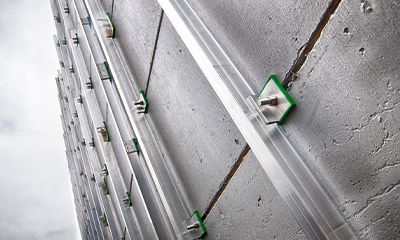Written by Hitesh Pattni (North) and Neil Kirwan (South) - Specification Managers in SFS Group Fastening Technology Ltd.
Contents:
The role of the building envelope today is, essentially, exactly the same as it was when people first sought shelter.
Meeting the needs of building occupants is an essential part of building design and construction. It is a major contributor in achieving a robust specification. But the way in which the different fundamental performance elements is delivered has never been more complex.
All of these factors serve to increase the choice of available solutions. They also make it harder to strike a balance of performance through the 'right' combination of choices. Meeting today's performance challenges is hard enough for designers and specifiers, without also thinking about making the building fit for the future - both of which contribute to a specification being robust.
Fire safety is, arguably, the area of building construction performance at the forefront of most construction professionals' minds - even more so than sustainability. Driven by constantly changing regulations and strict insurance demands, delivering robust fire safety specifications has perhaps never been more challenging. This paper will look into how to tackle that challenge.
All of this builds on the issues described in our first four robust specification papers, and complements the other building performance criteria discussed in the fifth and seventh papers in the series.
It reinforces the benefits of creating robust specifications that aim to eliminate performance gaps. It lends weight to the idea of welcoming greater client input. And it serves as a reminder why getting product experts - manufacturers - involved earlier is key.
Few areas of building regulation and specification have seen as much scrutiny and change in recent years as fire safety. That will remain the case for the foreseeable future, as the effects of the Grenfell Tower fire continue to be felt - both in the construction industry, and beyond it.
Nobody would argue that greater focus on fire safety measures and performance is a bad thing. It is worth asking the question, however, as to whether that focus and awareness is leading to a better understanding of how products, systems and whole buildings behave when the worst happens. Rising insurance premiums (especially for design professionals) and a culture of risk aversion have gone hand in hand as the industry has sought to navigate the changed landscape.
Where they weren't already, construction product manufacturers are rightly expected to be transparent about their product testing, with clear communication of results. Even where that clear communication is in place, a suitable product or system might be rejected from a specification due to risk averse thinking.
Specifiers find themselves looking for solutions that either the market can't provide, or which are a complete over-specification for the particular project, because expectations are not aligned with what is actually required, or available.
There are questions as to whether the testing regime generally, and for fire safety specifically, is doing enough...
National building regulations around the UK are in a state of flux, with amendments being made to technical guidance alongside longer-term reviews of the regulatory system and its suitability. Different requirements in the different countries of the UK only add to the complexity of the overall picture.
In Scotland, for example, combustible materials have been banned from external wall constructions in building work that exceed 11m in height, even where good test results have been demonstrated.
The regulations in England continue to use 18m as a threshold, with requirements applying to 'relevant buildings' but excluding 'specified attachments' that are part of the wall construction.
The direction of future regulations, and how they will align with the risk averse thinking of building insurers, is unclear. Could combustible materials be banned on buildings of any height?
What does good practice look like now, and is it possible to anticipate - and maybe even plan for - what good practice looks like in the future?
Changing thermal performance requirements are increasing insulation thickness in the building envelope. BR135 sets out the performance criteria for cladding systems in terms of fire safety, and we are already seeing building envelopes with insulation so thick that it cannot be fixed and also meet the criteria of BR135.
Early engagement in terms of fire safety allows specifiers to work closely with the manufacturers of building envelope systems. Through collaboration, it's possible to establish what is required and what solutions are available to meet those needs. Regulatory requirements can be met without over-specification. Perhaps most importantly for the specifier, they can progress through the later design stages confident of having a compliant solution, and without having assumed risk for its selection.
A prominent and well-respected structural engineer who works internationally was asked to provide a solution for the roof of a former mill building in the north of England. As part of the upgrade and retrofit of the building, the roof structure had to be modified on order to provide better thermal performance and fire safety.
The structural engineer was not in a position to specify a named solution for the roof structure modification. Nevertheless, when they approached SFS for advice we suggested, and provided data for, a stainless steel fixing that would allow new and existing timber joists to be secured without affecting the ceiling of building structure below (by avoiding a loading known as 'hammering').
Thanks to the specificity of the solution put forward, the structural engineer proposed that the architect and client engage directly with SFS.
This allowed the wider project team to work with us while having confidence that we were acting in the best interests of the project and the historic building.
Just as no individual specifier can be an expert in all areas of the building envelope, so one document cannot cover all areas of building envelope specification in the necessary level of detail.
This paper is one of a series exploring different areas relating to building envelope specification, and looking at the performance criteria that must come together in order to meet the client’s needs.
Ultimately, we want to show why and how prioritising early engagement on construction projects can lead to better building envelope specifications. Specifications that are robust, and which are the best for the individual project.
It’s no exaggeration that specifiers face a more complex and evolving landscape than ever before. Throughout these documents, we’ll show why the benefits of early specification, based on technical expertise provided by external parties, can far outweigh any potential drawbacks.
Robust Building Envelope Specifications
Paper 6: Robust fire safety specifications in buildings
- Introduction: building envelope performance
- Fire safety: do we understand it any better?
- Fire safety: navigating product testing and changing regulations
- Fire safety: how early engagement can tackle risk averse thinking
- Fire safety: case study
- SFS robust specification series
- About SFS Construction UK
Building envelope performance
The role of the building envelope today is, essentially, exactly the same as it was when people first sought shelter.
- Provide protection from the elements
- Offer a view to the outside
- Give occupants security
- Achieve a level of comfort inside compared to outside.
Meeting the needs of building occupants is an essential part of building design and construction. It is a major contributor in achieving a robust specification. But the way in which the different fundamental performance elements is delivered has never been more complex.
- Higher standards and greater expectations
- Compliance with compulsory regulations and voluntary standards
- Globalised supply chains capable of offering hundreds of different types of products
All of these factors serve to increase the choice of available solutions. They also make it harder to strike a balance of performance through the 'right' combination of choices. Meeting today's performance challenges is hard enough for designers and specifiers, without also thinking about making the building fit for the future - both of which contribute to a specification being robust.
Fire safety is, arguably, the area of building construction performance at the forefront of most construction professionals' minds - even more so than sustainability. Driven by constantly changing regulations and strict insurance demands, delivering robust fire safety specifications has perhaps never been more challenging. This paper will look into how to tackle that challenge.
All of this builds on the issues described in our first four robust specification papers, and complements the other building performance criteria discussed in the fifth and seventh papers in the series.
It reinforces the benefits of creating robust specifications that aim to eliminate performance gaps. It lends weight to the idea of welcoming greater client input. And it serves as a reminder why getting product experts - manufacturers - involved earlier is key.
Fire safety: do we understand it any better?
Few areas of building regulation and specification have seen as much scrutiny and change in recent years as fire safety. That will remain the case for the foreseeable future, as the effects of the Grenfell Tower fire continue to be felt - both in the construction industry, and beyond it.
Nobody would argue that greater focus on fire safety measures and performance is a bad thing. It is worth asking the question, however, as to whether that focus and awareness is leading to a better understanding of how products, systems and whole buildings behave when the worst happens. Rising insurance premiums (especially for design professionals) and a culture of risk aversion have gone hand in hand as the industry has sought to navigate the changed landscape.
Where they weren't already, construction product manufacturers are rightly expected to be transparent about their product testing, with clear communication of results. Even where that clear communication is in place, a suitable product or system might be rejected from a specification due to risk averse thinking.
Specifiers find themselves looking for solutions that either the market can't provide, or which are a complete over-specification for the particular project, because expectations are not aligned with what is actually required, or available.
Fire safety: navigating product testing and changing regulations
There are questions as to whether the testing regime generally, and for fire safety specifically, is doing enough...
- Do different parties associated with construction projects understand what is being tested, and why?
- Are the results communicated clearly - first from the test house to the manufacturer, and then from the manufacturer to their architectural and specification audience?
- Are national building regulations clear enough about what is required and why?
- Is there clarity about when to look for individual product performance, and when to look for system testing results?
- Is enough value placed on systems testing in the first place, especially when installers seek to substitute individual components in a building envelope system?
National building regulations around the UK are in a state of flux, with amendments being made to technical guidance alongside longer-term reviews of the regulatory system and its suitability. Different requirements in the different countries of the UK only add to the complexity of the overall picture.
In Scotland, for example, combustible materials have been banned from external wall constructions in building work that exceed 11m in height, even where good test results have been demonstrated.
The regulations in England continue to use 18m as a threshold, with requirements applying to 'relevant buildings' but excluding 'specified attachments' that are part of the wall construction.
Fire safety: how early engagement can tackle risk averse thinking
The direction of future regulations, and how they will align with the risk averse thinking of building insurers, is unclear. Could combustible materials be banned on buildings of any height?
What does good practice look like now, and is it possible to anticipate - and maybe even plan for - what good practice looks like in the future?
How will changing fire safety regulations impact on other performance criteria?
Changing thermal performance requirements are increasing insulation thickness in the building envelope. BR135 sets out the performance criteria for cladding systems in terms of fire safety, and we are already seeing building envelopes with insulation so thick that it cannot be fixed and also meet the criteria of BR135.
Early engagement in terms of fire safety allows specifiers to work closely with the manufacturers of building envelope systems. Through collaboration, it's possible to establish what is required and what solutions are available to meet those needs. Regulatory requirements can be met without over-specification. Perhaps most importantly for the specifier, they can progress through the later design stages confident of having a compliant solution, and without having assumed risk for its selection.
Fire safety: case study
A prominent and well-respected structural engineer who works internationally was asked to provide a solution for the roof of a former mill building in the north of England. As part of the upgrade and retrofit of the building, the roof structure had to be modified on order to provide better thermal performance and fire safety.
The structural engineer was not in a position to specify a named solution for the roof structure modification. Nevertheless, when they approached SFS for advice we suggested, and provided data for, a stainless steel fixing that would allow new and existing timber joists to be secured without affecting the ceiling of building structure below (by avoiding a loading known as 'hammering').
Thanks to the specificity of the solution put forward, the structural engineer proposed that the architect and client engage directly with SFS.
This allowed the wider project team to work with us while having confidence that we were acting in the best interests of the project and the historic building.
SFS robust specification series
Just as no individual specifier can be an expert in all areas of the building envelope, so one document cannot cover all areas of building envelope specification in the necessary level of detail.
This paper is one of a series exploring different areas relating to building envelope specification, and looking at the performance criteria that must come together in order to meet the client’s needs.
- Defining robust specification.
- The problem of performance gaps.
- Getting clients active and engaged.
- Early engagement: how do we get more of it?
- Thermal performance and sustainability.
- Fire safety.
- Corrosion, warranties and supply chain challenges.
Ultimately, we want to show why and how prioritising early engagement on construction projects can lead to better building envelope specifications. Specifications that are robust, and which are the best for the individual project.
It’s no exaggeration that specifiers face a more complex and evolving landscape than ever before. Throughout these documents, we’ll show why the benefits of early specification, based on technical expertise provided by external parties, can far outweigh any potential drawbacks.

 English (Canada)
English (Canada)
 čeština (Česká republika)
čeština (Česká republika)
 magyar (Magyarország)
magyar (Magyarország)
 Deutsch (Deutschland)
Deutsch (Deutschland)
 eesti (Eesti)
eesti (Eesti)
 español (España)
español (España)
 português (Portugal)
português (Portugal)
 English
English
 suomi (Suomi)
suomi (Suomi)
 français (France)
français (France)
 italiano (Italia)
italiano (Italia)
 Nederlands (Nederland)
Nederlands (Nederland)
 norsk, bokmål (Norge)
norsk, bokmål (Norge)
 polski (Polska)
polski (Polska)
 svenska (Sverige)
svenska (Sverige)
 Türkçe (Türkiye)
Türkçe (Türkiye)




